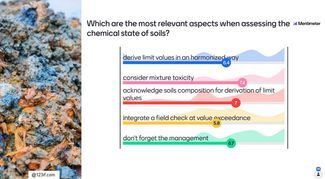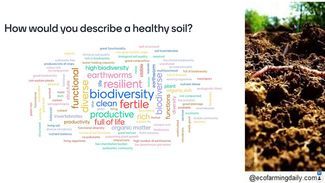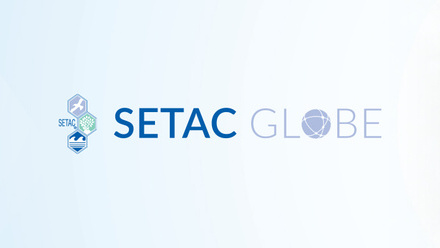On the Way to Effective Soil Protection in Europe
Pia Kotschik and Silvia Pieper, German Environment Agency; Claudia Lima, Wageningen University; and Susana Loureiro, University of Aveiro
The Topical Discussion, “On the way to an effective soil protection in Europe,” which took place during the SETAC Europe 33rd Annual Meeting last May in Dublin, Ireland, was initiated by the Global Soil Interest Group and led by the chairs Pia Kotschik, Silvia Pieper, Claudia Lima and Susana Loureiro. After two introductory talks, chairs and panel members Mathieu Renaud, Ecotoxcentre Switzerland; Mireia Marti, Swiss Federal Office for the Environment; Paola GrennI, Consiglio Nazionale delle Ricerche Instituto di Ricerca sulle Acque; Sandrine Andres, Ineris France; Mike Simini, U.S. Army; and Juliska Prince, Environment Canada, discussed the challenges and opportunities of the upcoming European Soil Health Law, now recognized as the Soil Monitoring Directive.
Aims of the European Soil Health Law – Possible Indicators for Soil Health
The first talk was by Kotschik and pointed to the need for better soil protection. Soil is precious due to its central role in food and drinking water provision, as habitat for soil biodiversity, and as storage of carbon and many other ecosystem services. However, action is required as pressure on soil is increasing, and existing gaps between the state of the environment and the targets of long-term legislative frameworks and strategies have been identified by several institutions. The Joint Research Centre states that more than 60% of European soil is threatened. The need for action is acknowledged by society, and a first proposal for a European Soil Law, the Soil Monitoring and Resilience Directive, was published. The Directive is based on the European Soil Strategy, with the overarching aim to reach 100% healthy soil by 2050. Such an ambitious aim can only be reached with an increase of research and data, as well as a European-wide monitoring program and the implementation of sustainable soil management. Possible indicators and thresholds for soil health have been suggested by the European Environment Agency in 2022. There, a three-step approach for soil pollution is described to classify chemical pollution of soil: acceptable values, warning values and action values, which are dependent on concentrations of chemicals in soil, their natural occurrence and in combination with effect values. Warning and action values might lead to restrictions in land use and/or specific risk management measures. The regulatory framework for chemical pollution is diverse and restricted to the assessment of single substance and single use, while in reality, multiple applications and residues are normal. Current risk assessment frameworks for chemicals do not consider effects on communities from multiple residues and therefore, soil biodiversity might be threatened to an unknown extent. Commonly proposed indicators for soil biodiversity include “diversity of earthworms” and “microbial communities,” whereby (un)acceptable effects on soil biodiversity might be classified by the “baseline and threshold approach.” However, the big question remains, "Do soil organisms cope with multiple applications of chemicals?" Kotschik suggested setting and implementing soil values for multiple contaminants, acknowledging effects on communities by integrating indicators of soil biodiversity, and describing the state and trends of soil invertebrates.
Threats in the European Union
Diana Vieira from the Joint Research Centre (JRC) described soil threats in the EU, emphasizing the need for soil protection, given the ecosystem services soils provide. The European Commission mentions 10 major soil threats: soil erosion, organic carbon change, nutrient imbalance, salinization and sodification, soil sealing and land take, loss of soil biodiversity, pollution, acidification, compaction, and water logging. In 2018, the JRC started to assess “healthy” and “unhealthy” soils in the EU. All available information collected to date was presented and is accessible on the EUSO Dashboard, which is publicly available for citizens. Soil degradation processes are categorized into 10 classes, ranging from zero to nine. The analysis shows that 61% of all European soils are unhealthy, with the major threat being loss of soil biodiversity. Loss of soil biodiversity was linked to several other major threats, such as soil carbon stock losses and soil erosion. The JRC evaluation shows that a large part of all soil pressures involves those three soil threats simultaneously. The data from the dashboard can also help analyze individual soil threats at different spatial scales. The ESDAC website makes soil health indicators and thresholds available and is supported by peer-reviewed publications. A regular update on current and possibly additional indicators is foreseen with increasing knowledge, since knowledge on some threats (e.g., soil pollution) is incomplete, and inclusion to all EU land uses is required. There are also plans to use the information on the dashboard with the new Soil Monitoring Directive.
Discussion

Following the presentations, a real-time survey was run to actively engage participants with the central question, “How would you describe a healthy soil?” Participants provided around 100 answers, which included prominent words such as biodiversity, fertile, resilient and diverse. The second question was, “Which are the most relevant aspects when assessing the chemical state of soils?” Participants identified mixture toxicity as the most important issue, followed by the acknowledgement of soil composition for the derivation of limit values.

Silvia Pieper acted as moderator and referred to the input from the presentations and the survey, which pointed at multiple threats to soil and recognized chemical pollution prominently. Depending on their purpose, chemical effects are assessed and regulated within several regulatory frameworks with different protection levels, although some countries have already established threshold values for certain chemicals. For example, Switzerland has three different threshold values (screening values, warning values and exceeding values) for chemical occurrence in soils, which are compared with monitoring results from soils sampled in the non-spray season. Depending on the outcome, further actions for soil protection might be needed. Additionally, soil organisms and soil quality should also be monitored to establish a longer-term objective of soil protection.
Mixture toxicity was a significant issue of discussion relative to effective soil protection, and some approaches are already available. However, within risk assessment, multiple chemical residues from various sources are not acknowledged within existing frameworks for soil risk assessment schemes. The new directive has the option of starting with threshold values for single chemicals and combining them within additivity models to acknowledge the co-occurrence in soil. Although chemical mixtures are occurring, there limitations in the lab; testing for a diverse set of chemicals is not always possible, nor cost-effective. Factors such as soil properties, and their influence on bioavailability, as well as mode of action, time and degradation also need to be considered. Predictive modeling was also suggested in identifying significant risks from chemical mixtures in soil, as was using monitoring as a tool to adapt threshold values over time through feedback mechanisms, thus creating a dynamic, rather than static risk assessment process. All participants agreed that additional research on mixture toxicity is required, as is the development of risk indicators and threshold levels for effective regulations for soil protection.
Central to reaching the European goal of 100% healthy soil is defining what healthy soil is, including thresholds for this good state. In the context of chemical regulation, prioritization of substances based on their biological activity in combination with (high) persistence could help to establish threshold values for soil protection and design monitoring studies. Based on monitoring results in combination with threshold values, needs for action can be identified. One possible restoration measure could be the reduction of diffuse pollution due to improvement of agricultural and industrial practices. For example, working with users (e.g., agriculture sector) to adapt alternate measures of pest management or implementing grant programs that encourage sustainable practices and the reduction of chemical use may contribute to reduced soil chemical pollution, without compromising soil fertility.
Author's contact: [email protected]


